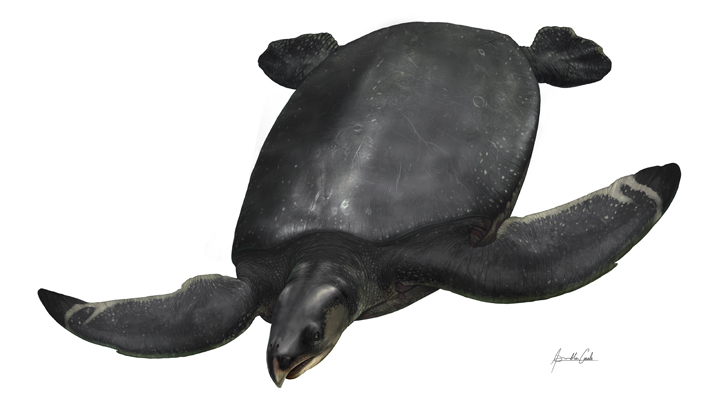Discovered at Pyrenees the remains of the biggest marine turtle of Europe

A study involving researchers from the ICP, linked institution to UAB, has described the new marine turtle species back from 83 million years ago: Leviathanochelys aenigmatica. Their scientific name means “the enigmatic leviathan turtle”, in reference to the Leviathan and its peculiar skeletal characteristics of this animal, which perplexed paleontologist that dig it.
The fossil remains of this marine reptile, from which it only has been possible to recover part of the shell and the pelvis, able to estimate that from head to tail it would measure 3,7 meters long. It represents the biggest marine turtle ever found in Europe and the second in the world, only overpassed by Archelon, a genus of marine turtle from North America, that reached up to 4,5 meters in length.
The scientific study suggests that Leviathanochelys would be one of the oldest representatives of the Chelonioidea turtle’s group, which includes all nowadays marine turtles.
A part of their colossal dimensions, the new turtle species shows protuberances at the front of the pelvis never observed in any other turtle, nor terrestrial or marine. The research team thinks these bony projections, which would be attaching musculature that controls the animal’s ventral contraction, might have participated in functions related to Leviathanochelys respiratory system. Moreover, the anatomic features of this new species suggest that it could have had a pelagic lifestyle and maybe was able to deep into great depths.
The discovery of the fossil remains took place in 2016 July by a hiker close to Cal Torrades, at Coll de Nargó (Alt Urgell) township, who reported the discovery to Espai Dinosfera, a paleontology divulgation centre from the Pyrenees linked to Museu de la Conca Dellà (at Isona, Pallars Jussà). A team composed of researchers and the Servei de Patrimoni Arqueològic i Paleontològic de la Generalitat de Catalunya displaced where fossils were found and organized an emergency excavation with the aim of preserving the remains that have been rested exposed from the earth. Posteriorly, they were deposited at Museu de la Conca Dellà waiting to be studied. For the purpose of a preliminary study from a master’s project, there were performed new digging campaigns at the fossil site that finally allowed the recovery of the posterior part of the shell and a nearly complete pelvis that nearly reaches 90 cm in width.
Institut Català de Paleontologia Miquel Crusafont (ICP), Universitat Autònoma de Barcelona
References
Castillo-Visa, O., Luján, À.H., Galobart, À. et al. A gigantic bizarre marine turtle (Testudines: Chelonioidea) from the Middle Campanian (Late Cretaceous) of South-western Europe. Sci Rep 12, 18322 (2022). https://doi.org/10.1038/s41598-022-22619-w

